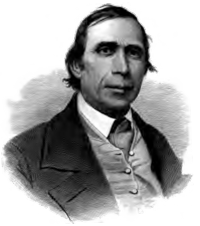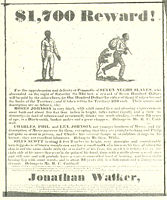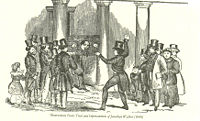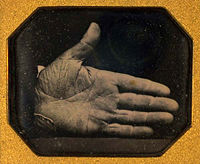Jonathan Walker
| Jonathan Walker | |
|---|---|
| Born | March 22, 1799 Harwich, Massachusetts |
| Died | May 1, 1878 Lake Harbor, Michigan |
| Spouse | Jane Gage Walker |
| Parents | Seth & Marcy Walker |
Captain Jonathan Walker (1799-1878) was a carpenter and shipwright who aided the escape of seven Pensacola slaves, for which he was imprisoned in the city's calabozo and his hand branded "SS" (for "slave stealer"). After his release he became a champion for the abolition movement.
Walker lived with his family in Pensacola from 1836 until 1841, then returned to his native Massachusetts "because he would not bring up his children among the poisonous influences of slavery."[1] He traveled to Mobile in 1843 to engage in the ship-wright trade.
On June 2, 1844, he sailed to Pensacola aboard his own vessel, intending to raise a copper-laden wreck, and arrived on June 4. After touring the area, he met several men "that were disposed to leave the place. I gave them to understand that if they chose to go to the Bahama Islands in my boat, I would share the risk with them." Seven slaves left with Walker on June 22:
- Charles, Phillip, and Leonard Johnson (three brothers claimed by George Willis)
- Moses Johnson and Harry and Silas Scott (claimed by Navy Lt. Commander Robert C. Caldwell)
- Anthony Catlett (claimed by Byrd C. Willis)
They sailed east along the Florida coast; search parties were organized to find them, but were thrown off by a false sighting west of Pensacola. The band put into St. George's Island to restock water, then proceeded through Apalacha Bay. Walker was prostrated by severe sunstroke, and his passengers unable to navigate the ship. They were rescued by two wrecking sloops on July 8 and taken to Key West.
The eight men were returned to Pensacola, where Walker was committed to the Spanish calabozo on July 19 under the watch of jailer Francis Torward. He remained jailed for several months, during which time he corresponded with attorney Benjamin Drake Wright, who served as his counsel. He was tried on November 14, and a federal jury quickly found him guilty on four indictments of slave-stealing. He was fined $150 plus court costs and sentenced to have his hand branded "SS" for "slave stealer." With no previous cases, authorities had to fashion a brand, but the first blacksmith they approached declined, feeling brands should be used only for animals. Pedro Yniestra consented to make the item, but refused to heat it in his own furnace.
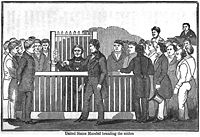
On November 16, his sentence was carried out. Walker was pilloried for one hour, during which time locals (and specifically George Willis) pelted him with rotten eggs. U.S. Marshal and Escambia County Sheriff Ebenezer Dorr IV ordered a fire built within the antebellum courthouse to heat the brand. Walker later recounted the experience:
When about to be branded, I was placed in the prisoner's box. Dorr … proceded to tie my hand to a part of the railing in front. I remarked that there was no need of tying it, for I would hold still. He observed that it was best to make sure, and tied it firmly to the post, in fair view; he then took from the fire the branding-iron, of a slight red heat, and applied it to the ball of my hand, and pressed it on firmly, for fifteen or twenty seconds. It made a spattering noise, like a handful of salt in the fire, as the skin seared and gave way to the hot iron. The pain was severe while the iron was on, and for some time afterwards.
After the branding, Walker was returned to the jail. Dorr served him three writs for trespass and damages totaling $106,000. He remained imprisoned for several more months, and on May 9 was arraigned on three more indictments. Walker was defended by W. W. J. Kelly, but again the jury (which included Mayor Charles Evans) returned guilty verdicts on all counts, with a sentence of $5 for each count. After a group of Northern abolitionists paid the bill of costs against him, totaling $596.05, Walker was released from jail on June 16, 1845.
For five years after his release, Walker lectured on slavery in the northern and western states. He moved to Michigan about 1850, where he lived near Muskegon until his death on May 1, 1878. A monument was erected to his memory on August 1, 1878. He was the subject of John Greenleaf Whittier's poem "The Branded Hand."
Images[edit]
Walker pilloried and pelted with eggs by George Willis
References[edit]
- Jonathan Walker. Trial and Imprisonment of Jonathan Walker, 1848. Google Books digital copy
- NNDB entry
- Branded Hand Home Page
